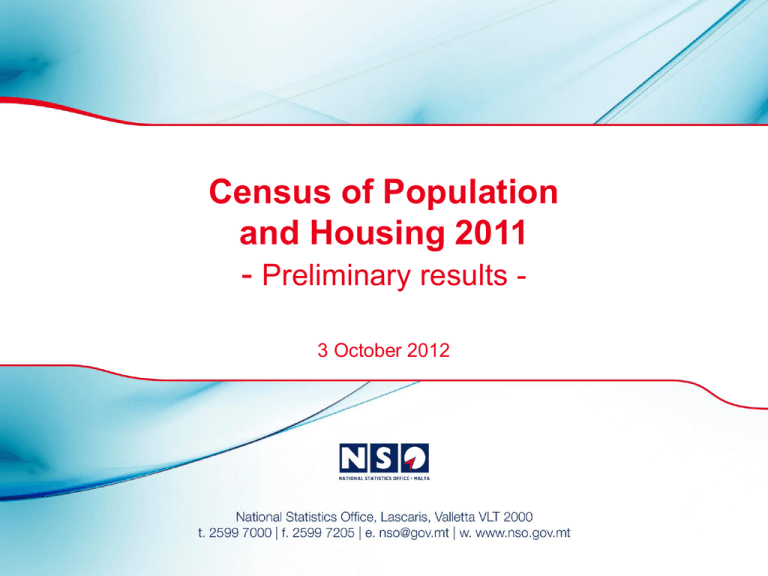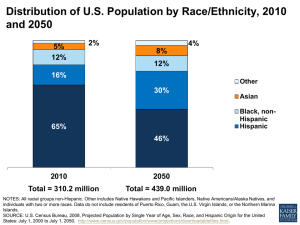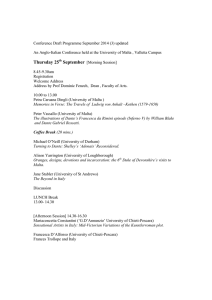
Census of Population
and Housing 2011
- Preliminary results 3 October 2012
Presentation Outline
• General Information
• Concepts and Definitions
• The Census questionnaire
• Preliminary results
• Post-Enumeration
Presentation Outline
• General Information
• Concepts and Definitions
• The Census questionnaire
• Preliminary results
• Post-Enumeration
• Legal background
• Participation in the Census
• Confidentiality
• Information Campaign
• Census Operations
• Fieldwork
• Inputting of Data
Presentation Outline
• General Information
• Concepts and Definitions
• The Census questionnaire
• Preliminary results
• Post-Enumeration
• Residents of Malta
• Place of usual residence
• Households
• Institutions
Presentation Outline
• General Information
• Concepts and Definitions
• The Census questionnaire
• Preliminary results
• Post-Enumeration
• Population section
• Housing section
Presentation Outline
• General Information
• Concepts and Definitions
• The Census questionnaire
• Preliminary results
• Post-Enumeration
• Population growth
• Geographical distribution
• Population density
• Gender distribution
• Age distribution
• Distribution by Nationality
Presentation Outline
• General Information
• Concepts and Definitions
• The Census questionnaire
• Preliminary results
• Post-Enumeration
• Follow-up exercise
• Accuracy of preliminary
findings
• Final report
General
Information
General Information
Legal Background
• A Census provides information about the count, characteristics,
composition and condition of the population and dwellings in a
country.
• The Census of Population and Housing is a form of national
stock-taking, usually held every 10 years.
• Census night: midnight of Sunday 20 November 2011.
• Malta aligned its censuses with the EU. The last census was
carried out in 2005.
• Census carried out in conformity with the Census Act of 1948
and Regulation 763/2008 of the European Parliament and
Council.
General Information
Legal Background
• The Census Order, made by the Hon. Prime Minister, was
published on 1 November 2011 by means of Legal Notice No.
419 of 2011.
• Mr. Michael Pace Ross, Director General of the National
Statistics Office, was appointed Census Officer.
General Information
Participation in the Census
• Participation in the Census is obligatory in terms of the
Census Act of 1948 and any person failing or refusing to
provide information may be subject to legal action.
• All residents are obliged to provide the information asked in the
questionnaire to the best of their knowledge as at Census
Night.
Confidentiality
• All information collected during the Census remains strictly
confidential, and any breach of confidentiality will render
involved individuals liable to a fine and/or imprisonment.
General Information
Information Campaign
• Extensive communications campaign carried out to maximise
public awareness and enhance co-operation (TV, Radio,
Newspapers, Magazines).
• Website (www.census2011.gov.mt) contained updated
information on the Census and the latest developments.
• Support was also available through the email address:
census2011@gov.mt.
• Freephone service (number 170) – operated between October
and December 2011 through a dedicated Call Centre - received
nearly 25,000 calls.
• Stand at the Malta Fairs and Conventions Centre (MFCC).
General Information
Census Operations
• Organisational structure (Census Office) set-up in the first quarter of
2011 to co-ordinate: methodology, logistics, information technology
and communications.
• Census process involved almost 1,200 persons, headed by the
Census Officer, including: two deputies, three co-ordinators, six
district managers, five area supervisors, 28 call centre operators, 91
supervisors, and 1,021 enumerators.
• Ex-Pilar School was rented to accommodate all Census operations.
• 41 schools across Malta and Gozo provided logistical support to
enumerators during the Census period.
General Information
Census Operations
Census Officer
Chief
coordinators
Census
Office
Area
Supervisors
District
Managers
Supervisors
Defines field operations
Enumerators
Defines data collection
General Information
Census Operations
• Large Recruitment process.
• Training and Briefing sessions to all Census staff (in Malta and
Gozo).
• Detailed manual provided to all staff involved in the data collection
process.
• Setting-up of 1,021 Enumeration Areas, consisting of a number of
streets or parts thereof in a particular locality covering an average
of 180-230 dwellings.
• All Maltese localities reflected the boundaries of the Local Council
and were grouped into six Districts, as per the Local Administrative
Unit (LAU) classification.
General Information
Census Operations
MALTA
Districts
[6]
Localities
[68]
Enumeration
Areas [1021]
Dwellings
General Information
Fieldwork
• Census questionnaires were mailed to 153,000 households in the
last week of October 2011.
• Census questionnaires were collected by the Enumerators between
7 November and 4 December 2011.
• Contact was not established with some households during the
Census period, which could have been living elsewhere in Malta or
were living abroad. These are still being followed up by the Census
Office.
• To date, over 146,000 Census questionnaires were collected, a
coverage of almost 98 per cent of the total estimated number of
occupied dwellings in Malta.
General Information
Inputting of Data
• During the Census period, a set of key variables from all
questionnaires received were entered on a daily basis. These
included:
- residential address information (of usual place of residence),
- name, surname, identity card number,
- date of birth, sex, acquisition of Maltese nationality
• This enabled Census Office to identify potential problematic areas
and to be able to start following-up households which were not
enumerated.
Concepts and
Definitions
Concepts and Definitions
Residents of Malta
• All Residents of Malta must be enumerated, including:
- Persons residing in Malta for a continuous period of at least 12
months before 20 November 2011; or
- Persons who arrived in Malta during the 12 months before 20
November 2011 with the intention of staying in Malta for at
least 12 months; or
- A person who moved to a country other than Malta for a period
of less than 12 months and has the intention to return to Malta;
or
- Persons who may be illegal, irregular or undocumented
migrants, asylum-seekers and persons who have applied for or
been granted refugee status or similar types of international
protection.
Concepts and Definitions
Place of Usual Residence
• Place where a person normally spends his/her daily period of rest,
regardless of temporary absences for purposes of recreation,
holidays, visits to friends and relatives, business, medical treatment
or religious pilgrimage.
• A person is temporarily absent from his/her place of usual
residence if he/she is absent, or expected to be absent, at the time
of the Census for less than 12 months. Temporarily absent persons
are also included in the total enumerated population.
• Address of place of usual residence need not necessarily be the
same as the one on the person’s identity (ID) card.
Concepts and Definitions
Households
• A household is defined in terms of shared residence and common
arrangements, as:
- One person living alone; or
- A group of persons (not necessarily related) living at the same
address with common house-keeping i.e. sharing a meal on
most days or sharing a living or sitting room.
• A dwelling is a building that is used entirely or primarily as a
residence, including any associated structures, such as garages,
and all permanent fixtures customarily installed in residences.
• Homeless persons who may live without a fixed place of shelter are
also enumerated.
Concepts and Definitions
Institutions
• An institution is understood to be a legal body for the purpose of
long-term inhabitation and provision of services to a group of
persons.
• Institutions have common facilities shared by the occupants such as
cooking and toilet facilities, baths, lounge rooms or dormitories.
• Institutional households comprise persons whose need for
shelter and subsistence is being provided by an institution. These
include: homes for the elderly, convents and monasteries, hotels,
hospitals, prisons, convalescent homes, welfare institutions, etc.
Census
Questionnaire
Census Questionnaire
• Divided into two parts:
• Demographic and socio-demographic topics (Population), and
• Housing.
• Prepared after consultation meetings were held with a number of
Organisations in June and July 2011.
• Ensures continuation with previous censuses carried out in Malta. It
also conforms to the recommendations, concepts and definitions on
population censuses of the United Nations Economic Commission for
Europe (ENECE) and Eurostat.
• Pilot-tested among a random sample of households in August.
• Provided in Maltese or English language.
Preliminary Results
Preliminary Results
Population Growth along the years
• Total estimated population in 2011 stands at 416,055.
• Of these, 8,710 persons reside in institutions, the majority of which
are homes for elderly people.
• The majority of persons residing in institutions are females (55.5 per
cent) and aged 65 or over (54.0 per cent).
Preliminary Results
Population Growth along the years
Population counts between 1842 and 2011
50,000
212,258
184,742
165,037
149,782
134,055
100,000
123,496
150,000
141,775
200,000
211,564
416,055
378,132
314,216
319,620
305,991
250,000
241,621
300,000
114,499
population count
350,000
345,418
400,000
404,962
450,000
0
1842 1851 1861 1871 1881 1891 1901 1911 1921 1931 1948 1957 1967 1985 1995 2005 2011
year
Preliminary Results
Population Growth along the years
• In 100 years, Maltese population nearly doubled, from 211,564 in
1911 to 416,055 in 2011.
• Largest average annual population growth was recorded between
1931 and 1948 with 3,786.
• Between 1957 and 1967, the population decreased by 5,404, this
being attributed to a substantial number of Maltese residents who
emigrated.
• Population growth rate increased at a lower rate between 2005
and 2011.
intercensal period
2005-2011
1995-2005
1985-1995
1967-1985
1957-1967
1948-1957
1931-1948
1921-1931
1911-1921
1901-1911
1891-1901
1881-1891
1871-1881
1861-1871
1851-1861
1842-1851
% change
Preliminary Results
Population Growth along the years
Percentage intercensal change
30.0
25.0
20.0
15.0
10.0
5.0
0.0
-5.0
Preliminary Results
Geographical distribution: Districts
• Largest concentration of the population was in the Northern
Harbour District with 28.9 per cent of the entire population
(120,063 residents).
• Smallest district was Gozo and Comino with 7.5 per cent of the
population (31,143 residents).
Gozo and
Comino, 7.5%
Southern
Harbour District,
19.0%
Northern
District, 15.3%
Western District,
13.9%
South Eastern
District, 15.4%
Northern
Harbour District,
28.9%
Preliminary Results
Geographical distribution: Districts
Population distribution by district: 1995, 2005 and 2011
Southern Harbour District
district
Northern Harbour District
South Eastern District
Western District
Northern District
Gozo and Comino
0
15,000
30,000
45,000
60,000
75,000
population count
2011
2005
1995
90,000
105,000 120,000 135,000
Preliminary Results
Geographical distribution: Districts
• Largest increase over the years was observed in the Northern
District, with increases of 41.8 per cent and 11.2 per cent over
1995 and 2005 respectively.
• This was followed by the South Eastern District, with increases of
26.6 per cent and 8 per cent from 1995 and 2005 respectively.
• These two districts were the only ones with an increase larger than
the national average.
• The Southern Harbour District was the only district showing a
drop in population along the years, from 83,234 in 1995 to 81,047 in
2005 and 79,203 in 2011.
Preliminary Results
Geographical distribution: Localities
• 16 localities in Malta had more than 10,000 residents, with an
average of 7,128 in Malta compared to 2,224 in Gozo.
• The largest 12 localities in Malta remained unchanged.
• Largest locality was Birkirkara with 21,533 residents, followed by
Mosta and St. Paul’s Bay, with 19,560 and 16,478 residents
respectively.
• Smallest locality remained Mdina with 237 residents.
• Xgħajra had the largest growth rate with 26.5 per cent, followed by
Birżebbuġa and St. Paul’s Bay, with 22.9 per cent each.
• Largest decline in population was observed in Ta’ Xbiex with 16.8
per cent, followed by Mdina (14.7 per cent) and Senglea (14.7 per
cent).
Preliminary Results
Geographical distribution: Localities
Percentage difference in population between 2005 and 2011 by locality
Ta' Xbiex
Mdina
-16.8
-14.7
Senglea
-11.5
-10.5
Locality
Marsa
Qala
11.1
Ħal Għargħur
11.1
Santa Venera
11.9
Mellieħa
12.1
Mġarr
14.4
Pembroke
17.3
Marsaskala
18.3
St Paul's Bay
22.9
Birżebbuġa
22.9
Xgħajra
-20.0
26.5
-15.0
-10.0
-5.0
0.0
5.0
% difference
10.0
15.0
20.0
25.0
30.0
Preliminary Results
Geographical distribution: Localities
• A change in trend was observed in a number of localities since
1995.
• Population in Birkirkara and Iklin increased since 1995 but
decreased since 2005.
• On the contrary, Tal-Pieta’ recorded a drop in population between
1995 and 2005 and an increase between 2005 and 2011.
• Other localities showed similar patterns.
Preliminary Results
Population density: Malta within the EU
• Malta remains by far the most densely populated European Union
Member State.
• Malta has an average of 1,320 persons/km2, compared to an overall
average of 116.6 persons/km2 for the 27 Member States.
• The second most densely populated country within the EU is the
Netherlands, with a density of 492,2 persons/km2.
country
Sweden
Latvia
Ireland
Greece
Spain
Slovenia
France
Slovakia
EU 27
Denmark
Luxem.
Germany
Belgium
Malta
population per km
2
Preliminary Results
1,400
1,200
1,000
800
600
400
200
0
Preliminary Results
Population density: Malta and Gozo
• Malta (1,562 persons/km2) is three times more densely populated
than Gozo (454 persons/km2).
• Population density in Malta has increased at a higher rate since
2005 (45 persons/km2) unlike Gozo where the increase was marginal
(2 persons/km2).
Population density: Districts
• The Northern Harbour District (4,997 persons/km2) and Southern
Harbour District (3,026 persons/km2) were the two most densely
populated districts in Malta.
• Sourthern Harbour District was the only district in Malta showing a
drop in population density since 2005 (- 71 persons/km2).
Preliminary Results
Population density: Localities
Intercensal change in population density by locality 2005-2011
Tarxien
812
Santa Venera
800
465
Tal-Pietà
Ħal Balzan
437
Xgħajra
341
319
locality
Marsaskala
Pembroke
220
Birżebbuġa
213
St Paul's Bay
211
Paola
-219
San Ġwann
-232
Santa Luċija
-342
-429
Vittoriosa
Cospicua
-448
Ħamrun
-483
-614
Valletta
Ta' Xbiex
Senglea
-1072
-2209
-2,250 -2,000 -1,750 -1,500 -1,250 -1,000
-750
-500
change
-250
0
250
500
750
1,000
Preliminary Results
Population density: Localities
• The three most densely populated localities in Malta remained the
same as in 2005, with Senglea being the most dense (17,028
persons/km2) followed by Tas-Sliema (10,426 persons/km2) and Fgura
(9,989 persons/km2).
• Senglea continued to experience significant decrease in density with a
drop of 5,050 and 2,209 persons/km2 compared to 1995 and 2005.
• Għasri, which is the least densely populated locality in the Maltese
islands (85 persons/km2), is the only locality inline with the overall EU
average.
Preliminary Results
Gender distribution
• In 2011, the Maltese population still comprised made up of more
females than males, although the gap between the two sexes
continued to narrow.
• Males continued to increase at a higher rate than females after
1957.
• Compared to 2005, males increased at a rate of 3.2 per cent
compared to 2.3 per cent for females.
• The number of females per 1,000 males has gone down to 1,008
from 1,088 and 1,024 in 1957 and 1995 respectively.
Preliminary Results
Gender distribution
Num ber of fem ales per 1000 m ales: 1842-2011
1,100
1,080
1,040
1,020
1,000
census
2011
2005
1995
1985
1967
1957
1948
1931
1921
1911
1901
1891
1881
1871
1861
1851
980
1842
number
1,060
Preliminary Results
Age distribution
• Shift in age composition of the population towards an older
population continued to materialise, since 2005.
• Persons aged 65 and over represent 16.3 per cent of the total
population, compared to 13.7 per cent in 2005.
• Persons aged 14 and under make up 14.8 per cent of the
population compared to 17.2 per cent in 2005.
• Average age of the Maltese population increased from 38.5 in 2005
to 40.5 in 2011.
• The average age in Gozo and Comino (41.6 years) was higher than
that observed in Malta (40.4 years).
Preliminary Results
Age distribution
Age distribution: 2005-2011
0-14
15-24
age group
25-34
2011
35-44
2005
45-54
55-64
65+
0.0
5.0
10.0
%
15.0
20.0
Preliminary Results
Age distribution: Localities
• Mdina is the locality with the oldest population (average of 52.1
years), followed by Floriana (48.3 years) and Ħal Luqa (48.2 years).
• Pembroke, Xgħajra and Mtarfa have the smallest average age (less
than 35 years).
• Compared to 2005, the largest increases in average age where
observed in Mdina (+5.1 years), Ta’ Xbiex (+4.7 years) and Iklin
(+4.3 years).
Preliminary Results
Age distribution: Malta within the EU
• Malta’s old-age dependency ratio stands at 23.7 per cent,
compared to 25.9 per cent across the EU. Malta’s population is still
relatively young compared to the EU.
• This percentage stood at 17.2 per cent in 1995 and 19.9 per cent in
2005 and hence a remarkable increase was seen over the past
years.
The old-age-dependency ratio is defined as the proportion of
persons aged 65 and over divided by the working-age
population of persons aged 15 to 64
country
Slovakia
Ireland
Cyprus
Poland
Luxemb.
Romania
Czech Rep.
Netherlands
Malta
Slovenia
Lithuania
Hungary
UK
Latvia
Spain
Estonia
Denmark
France
Bulgaria
EU 27
Austria
Belgium
Finland
Portugal
Sweden
Greece
Italy
Germany
%
Preliminary Results
Age distribution: Malta within the EU
Old-age-dependency ratio by country
35
30
25
20
15
10
5
0
Preliminary Results
Distribution by Nationality
• Of the total population (416,055 persons), 20,086 (4.8 per cent) are
non-Maltese nationals compared to 12,112 persons (3 per cent) in
2005 (an increase of 65.8 per cent).
• The largest proportion of non-Maltese nationals are males (52.9 per
cent) and have an average age of 39.5 years.
• Nearly one fourth of non-Maltese nationals are aged between 25
and 34 compared to 14.1 per cent of Maltese nationals.
• The majority of non-Maltese residents (37.6 per cent) reside in the
Northern Harbour District compared to 28.4 per cent of Maltese
nationals.
• A smaller percentage (8 per cent) of non-Maltese residents reside in
the Southern Harbour District when compared to Maltese residents
(19.6 per cent).
Post-Enumeration
Post-Enumeration
Follow-ups
• Monitoring of individuals featuring in official and in-house registers
who were not enumerated to ensure the most comprehensive
enumeration rate possible.
• Follow-up letters sent in March 2012.
• Legal letters sent in September 2012.
Post-Enumeration
Final report
• A more accurate population count will be presented in the Final
Report as most of the remaining households and residents would
have been enumerated by then.
• The Final Report will also include a detailed analysis of the
population and other information collected in the 2011 Census.
• The Final Report will be available in the first quarter of 2013.
Thank you
Any questions?






